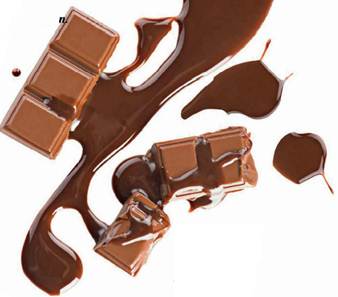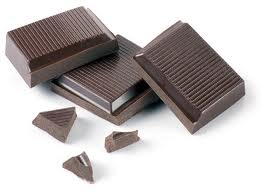On the one hand, we’re told chocolate is
too fatty to be good for us. On the other, it’s so loaded with antioxidants
that you’d be crazy not to eat it, with a study released last year finding that
gram for gram chocolate contains more health-promoting polyphenols and flavones
than fruit juice.

The truth is a combination of both, with
scientists continuing to add the list of ways chocolate boosts and protects
health, while at the same time acknowledging that less is definitely more when
it comes to how much you should eat.
So, from fighting tooth decay and heart
disease to easing emotional stress and improving your sight, here’s what the
latest scientific studies reveal about the many health benefits of chocolate.
Eases emotional stress
After two weeks of eating 40g of chocolate
a day, volunteers in a Swiss study, chosen because they were experiencing high
levels of stress, reported significant reduction in stress hormones and other
stress-related biochemical changes. The scientists behind the research say it
gives merit to the idea that chocolate is a salve in times of emotional
turmoil.
Fights tooth decay
A cocoa-powder extract that occurs
naturally in chocolate is being considered as a potential addition to
toothpaste by American researchers, in the fight against cavities. A white,
crystalline powder, the extract helps harden tooth enamel, something that makes
teeth less susceptible to decay, and is potentially more effective than
fluoride at protecting against cavities.
Protect against stroke
Canadian researchers discovered that people
who ate just one serve of chocolate a week were 22 per cent less likely to have
a stroke compared to people who stuck to chocolate-free diets. Saying the
protection may be thanks to chocolate’s high flavonoid content, the same
researchers also revealed how the sweet treat was beneficial even in the event
of a stroke, with chocolate eaters being 46 per cent less likely to die after
they’d had one.

Lowers blood pressure
Adelaide-based researchers say the flavones
in chocolate promote vasodilation, where blood vessels widen, to lower blood
pressure in people with hypertension. Comparing the reduction in systolic blood
pressure to that induced by 30 minutes of daily physical activity, researchers
believe it may add up to a 20 per cent reduction in the risk of a
cardiovascular event over a five-year period. But it’s important to remember
that less is more, with a separate study finding that a 125kJ serve of
chocolate a day was enough to produce a positive effect on blood pressure.
Improve your eyesight
UK scientists recently proved that
low-contrast eyesight, which is the type you need to see in situations like bad
weather, improves after eating dark chocolate. The University of Reading
researchers say the result, like many of chocolate’s health benefits, is down
to flavones, antioxidants that increase blood flow to the brain and retina.
The darker the chocolate, the healthier it is, right?
Sometimes, but not always. It’s natural to
assume that the darker the chocolate, the more cocoa it contains so the more
antioxidants it provides, but it depends on how the chocolate is processed.

Research shows that methods used to
decrease cocoa’s naturally bitter flavor – including fermentation, alkalizing
and roasting – can significantly reduce flavone levels and boost color
intensity, which means you can’t necessarily judge a chocolate’s antioxidant
content by its color or cocoa reading. Researchers are encourage chocolate
manufacturers to start listing flavone levels on labels, but until that happens,
they still recommend choosing dark, cocoa-rish chocolate over milk varieties,
and opting for brands that don’t use “Dutched cocoa”, which reduces bitterness
but eliminates antioxidants.
Know your limits
Chocolate is typically high in saturated
fat, a type of fat which, according to the Heart Foundation, should make up
less seven per cent of your total daily energy intake. As a guide, to stick to
the amount of kilojoules recommended for the average Australian adult, it means
eating no more than 16g of saturated fat a day. Here’s what a 30g serve of
different types of chocolate contains.
·
Dark chocolate: 5.1g saturated fat = 32 per cent
of daily intake.
·
Milk chocolate: 5.6g saturated fat = 35 per cent
of daily intake.
·
White chocolate: 6.5g saturated fat = 40.5 per
cent of daily intake.
·
Milk chocolate with nuts: 4.3g saturated fat =
27 per cent of daily intake.
·
Milk chocolate with creamy filling: 4.6g
saturated fat = 29 per cent of daily intake.